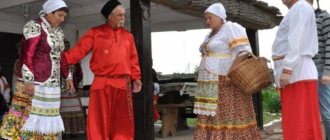Long tradition
Due to inexperience, many people believe that during matchmaking it is customary to make a marriage proposal and present a ring. Not at all. Today, the matchmaking ceremony is perceived as an acquaintance between the parents of the bride and groom. This ritual, in the modern sense, is a very important event for which the parties prepare in advance: future fathers-in-law and mother-in-law buy formal outfits, and fathers-in-law and mother-in-law set rich tables.
But before everything was completely different. Not only the groom’s relatives gathered for the matchmaking ceremony. For this action, matchmakers were hired, and important negotiations fell on their shoulders, for example, matchmakers discussed the size of the bride’s dowry.
As a rule, the appearance of matchmakers was unpredictable; no one could predict this event in advance. It was believed that the effect of spontaneity would not allow the bride’s family to hide their household, or, conversely, embellish it, and at the same time, the future bride.
And one more very important nuance. The decision about the upcoming wedding (whether it will happen or not) was made not by the young (as is now happening), but by their relatives.
Groom's wedding in Rus'
Brides in Rus' always followed a few days after matchmaking and were considered the second important stage of pre-wedding events.
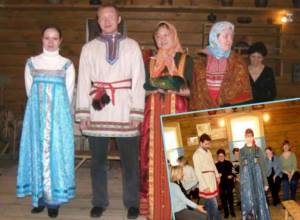
The groom's viewing party was organized in order to get to know him better, understand his character, talk with him on various topics, learn about his childhood, about his family.
Not only the groom himself and his personal qualities were assessed, but also viewings of the groom’s house were arranged.
The wealth of the family into which the parents send their daughter and the availability of everything necessary for a comfortable life were especially assessed. If during the viewing it turned out that the groom was poor, then the bride’s parents could refuse the wedding.
It was believed that at the bridesmaid ceremony a young man could be asked a variety of questions, even uncomfortable ones, and the groom had to answer them honestly and without concealment.
Traditionally, the main person at the bride's ceremony is the father of the bride.
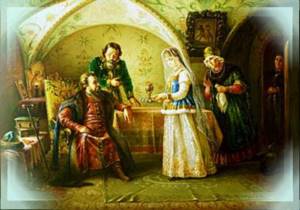
If the bride does not have a father, then an older brother or godfather replaces him. The bride's uncle can also replace the father in case of his absence. The mother of the bride is also allowed to be present during the viewing.
The entire viewing process began with prayer. Then you had to walk around the table three times.
Next, the hosts seated the guests at the table and a tea party was held. During the feast, guests learned everything they were interested in about their future son-in-law.
After tea, guests could ask to inspect the house or farm. While inspecting the groom's farm, the bride's relatives asked questions about how the groom manages it, how he looks after the cattle, what he feeds, and where he gets the food.
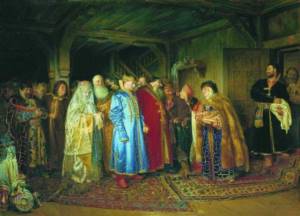
Also, during the viewing, one could ask about the size of the groom’s income and how he earns it.
Inspecting the kitchen and household utensils also had its practical significance, because the future wife would have to spend a lot of time in this part of the house.
Relatives had to evaluate whether everything was enough for good housekeeping and the convenience of the housewife.
The presence of copper utensils in the kitchen was considered a sign of family wealth.
Only after the viewing, during which the relatives of the future wife carefully inspected the household, did they give the final answer to the groom's family about whether the wedding would be planned or not.
After the successful viewing, a feast followed as usual, and the engagement took place.
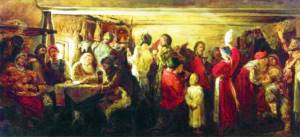
If, after the viewing, the guests refused to sit down at the table, then it was considered that the viewing was unsuccessful.
The guests from the bride’s side did not like something about the household and they considered the groom to be insufficiently wealthy, and therefore unworthy of their daughter. For this reason, the wedding could have been cancelled.
Traditional script
Once upon a time, the bride's matchmaking scenario involved the matchmaker visiting the potential bride's family several times. Moreover, making a decision about the upcoming wedding immediately after the first visit was considered a sign of bad taste. It's not surprising. The bride must “keep her mark”! And the relatives of the bride for matchmaking could not give the “goods” to the first person they met. However, there was a high probability that after the first visit, in case of refusal, the matchmakers would not return.
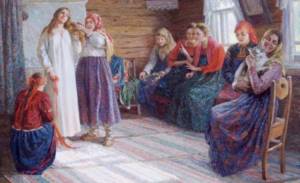
To prevent this from happening, the daughter’s parents asked for time to think, consult with other relatives, and find out more about the groom.
If everything worked out as it should, the matchmakers returned again after a few days. If the verdict was positive, the wedding date, expenses, dowry and “compensation” were discussed. After negotiations, future relatives (mother-in-law and father-in-law) were invited to visit to see where and how their beloved daughter would live now. Only after this could the groom meet his betrothed.
Riddles about love
Riddles for wedding competitions from the presenter can be about the most beautiful feeling in the world - love:
- What jumps, pulsates and is responsible during lovemaking? (Heart)
- Sweet, but not honey. Capable of killing, but not poison. (Love)
- The lovers met on the bridge. The girl said: “If you love me, jump down!” The guy didn’t do this, but was able to prove his feelings with just one word. What did he say? (Push)
- Who can pierce the heart with an arrow and not be punished? (Amur)
- What organs do lovers fuse together? (with hearts)
- Before war they pray once, before going to sea - twice. When should you pray three times? (When I decided to get married)
Which options to choose (serious or humorous) depends on the invited guests and their sense of humor.
Engagement tradition
After the matchmaking, which could last for more than one day, an engagement was organized. It was during the engagement that the bride and groom officially promised each other, the ring was presented, and the newlyweds exchanged vows in front of the altar and witnesses that the wedding would certainly take place according to mutual desire.

Today, engagement is a completely different event. For some, this is the moment of presenting a ring to a girl, for others - an announcement about the upcoming wedding, for others - family gatherings, during which the parents of the future spouses officially meet. And for some, engagement is considered the day when an application is submitted to the registry office. But in any case, engagement is considered the first step towards preparatory wedding events.
LiveInternetLiveInternet

Traditionally, the cycle of forming a new family is divided into several stages: • pre-wedding rituals (dating, bride viewings, maiden fortune-telling); • pre-wedding rituals (matchmaking, bridesmaids, collusion, bachelorette party and groom's gatherings); • wedding ceremonies (departure, wedding train, wedding, wedding feast); • post-wedding rituals (second day, visits).
Matchmaking The role of matchmakers was usually played by the groom's relatives, who enjoyed special respect, sometimes by his parents or even specially invited people known for their eloquence and charm. Sometimes they used the services of matchmakers, who had to first select the bride: find out what kind of dowry was given for her and what it consisted of - clothes, money or estates. In addition, through the matchmaker, the groom learned details about the beauty and character of the bride, whom in some cases he could see openly only on the wedding day. If successful, the matchmaker received a certain reward from the interested party and always a cashmere shawl. Entering the porch of the bride’s house, the matchmaker stepped on the first step with her right foot and said: “As my foot stands firm and strong, so my word will be firm and strong, harder than stone, more moldable than glue and pine sulfur, sharper than a damask knife; whatever I think will come true.” The matchmaking date was chosen specifically. First of all, it had to be an odd number, but in no case the thirteenth; the ideal option would be the third, fifth, seventh or ninth of the month. Matchmaking, as a rule, went after sunset. After the matchmakers left, one of the household tied all the pokers and grips together - for good luck in the business. On the way, it was advisable not to meet anyone you knew and under no circumstances talk to anyone. Before knocking on the door, it was imperative to touch the door frame with your shoulder or hand. After being invited into the house, one was first supposed to cross oneself and only then start talking about a future marriage. And the surest sign of business success is to touch, before starting negotiations, the leg of the table at which the conversation most often took place. In a conversation, one was not supposed to call a spade a spade: the conversation began with unrelated topics and the negotiations began directly in an allegorical form: “We are looking for a heifer, is she lost?” or “We want to buy a heifer,” “You have a product, we have a merchant,” “We you are a marten, we have a hunter,” etc. If the answer was positive, the bride’s parents and the matchmakers had to walk around the table three times, and if not, the matchmakers moved away, trying to close the door with their backs, which was supposed to prevent the girl from getting married. The matchmaking took place in two stages - at the first, a fundamental decision was made on whether the marriage would take place, and the next day they agreed on a viewing party, which, according to custom, took place a week later in the bride’s house.

Bride This event consisted of two parts - the introduction of the bride and groom and bargaining for the dowry. The main character of this event is the bride, who sought to appear before the groom's parents in the best possible way. According to custom, she had to change clothes at least three times, show her skills as a needlewoman and prepare the treat with her own hands. Then the parents of the future spouses retired to negotiate the size of the dowry. If an agreement was possible, the groom and his parents went out into the hallway or onto the porch, where they exchanged opinions about the bride, even if they knew her well. When they returned, the groom was served a glass of honey drink. If he agreed to take the girl as his wife, he drank it whole, if not, he returned it full. After this, they agreed on the date of the conspiracy, which was usually arranged two to three weeks after the show. Conspiracy This event took place in the bride’s house, and the closest relatives of the bride and groom gathered for it. In essence, it was an engagement, an announcement of the young people’s decision to get married, at which the conditions for marriage were discussed, the wedding was planned, the gifts that the bride, groom and immediate relatives were supposed to give, and the wedding day was set. From the day of the agreement, the bride and groom were not supposed to see each other; they communicated only with the help of notes and could give each other gifts. It was by agreement that the bride was supposed to cry, even if she liked the groom and was marrying for love. The conspiracy ended with prayer, the bride, groom and relatives walked around the table three times. The matchmaker was the main character of the conspiracy, arranging the marriage, she had to comply with many conventions: she was not supposed to sit down during the entire wedding agreement (otherwise the young children would “sit” for a long time - they would get back on their feet late), she should not have eaten and drink, protecting future children from gluttony and drunkenness. Entering the hallway, the matchmaker secretly stole a broom and hid it in the frills of her wide skirt during the entire agreement: then, according to legend, the matchmaking should have been successful. For the same purpose, before the start of the conspiracy, the matchmaker warmed her hands by the stove - it was believed that the spirits of deceased relatives lived in the stove, therefore, by warming her hands, the matchmaker showed them respect and asked for advice. As soon as the matchmaker entered the house, the doors were immediately locked with a hook so that a random guest entering the house would not jinx the future bride and groom. For the same purpose, it was forbidden to open the door to anyone until the end of the conspiracy. On the second day after the conspiracy, a ceremony was performed to present the bride with God's mercy - icons, which were later taken to the groom's house along with her dowry. These included an icon of parental blessing. This ceremony was attended by the godmother and godfather, who also blessed the icon. From this day on, the bride was freed from all housework; she had to deal only with the dowry and preparations for the wedding. Signs and customs of the conspiracy • The handkerchief over which the newlywed, while still in agreement, cried, remained forever in the parents' house, so that she could live married without crying. • The wedding agreement was not held on Wednesday and Friday - fasting days (fasting on these days is associated with the fact that on Wednesday Judas betrayed Christ, and on Friday Christ was
crucified)
.

Hand-shaking This event took place a few days before the wedding. The matchmakers with the father and mother of the groom, accompanied by relatives, went to the father and mother of the bride. The invitees sat at a table covered with a tablecloth, on which there was a pie and salt. The bride's father lit a candle in front of the image, and everyone in the hut stood up and locked the doors so that no stranger could jinx it. With prayer, the parents of the young couple clasped the right hands of the matchmakers across the table, and, taking the pie from the table, passed it around their hands, saying three times: “The deed is done, strengthened with bread and salt, forever and ever, amen.” The pie was broken over the hands, one half was given to the father of the groom, and the other to the father of the bride (whose half turns out to be larger - he has more strength, happiness, health, longevity and wealth). The pie was supposed to be kept by the bride and groom until the wedding, and after the wedding the newlyweds were supposed to eat it first; and the groom - the bride's half, and the bride - the groom's half. At the same time they said: “Eat, dear ones, for the glory of God, for eternal, endless love, just as the dough is in a pie, so is your flesh together until the end of time, heaven and earth, amen.” On the eve of the wedding. Bachelorette party The groom sent gifts to the bride - needles, threads, silk, canvas, scissors and other needlework supplies. According to tradition, it was necessary to put whips and raisins and other dried fruits and sweets in the gift chest. This gift meant that if the future wife insulted or offended her husband, she would be beaten with a whip, and if she behaved well, he promised with raisins and sweets that she would not lack expensive things. The groom also had to give the bride jewelry for the wedding dress, a comb, a mirror, blush, perfume and soap. In response, the bride sent the groom shirts or other clothes and scarves of her own making. At the bachelorette party, the bride said goodbye to “beauty” - a brocade headband with braids and ribbons, which the girl wore at festivities and round dances, which was carried away by her sister or friend. It was a sad day - the bride was saying goodbye to her girlhood and preparing herself for the difficult trials of family life. On the eve of the wedding, a bathhouse was heated for the bride, which was guarded by the groom's friends or the bride's relatives - guards. Usually the bride's brother heated the bathhouse, and the sister carried the water. In the bathhouse, the bride washed herself with soap sent by the groom, and treated her friends who accompanied her to sweets sent by the groom. At the end, the bride, without looking, threw soap, a broom, and a ribbon from her braid over her shoulder; a friend who managed to catch any of these objects, according to legend, was soon to get married.
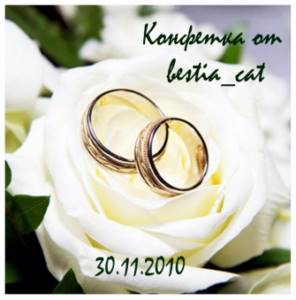
Successful dates for matchmaking
So, first of all, decide on the day and date. It is believed that the unsuitable days for matchmaking are Wednesday and Friday. In addition, you cannot send matchmakers to the bride on the 13th. The most suitable and successful numbers are 3, 5, 7, 9.

Today they do not use special ritual objects. Previously, this action could not be done without a towel (it was embroidered in a special way, with certain designs), and special utensils. Also, the ritual took place according to a script - the speeches and actions of all relatives were prepared in advance. The girl was silent the whole time the matchmaking was going on, quietly removing the ash from the stove. She had no right to turn to the matchmakers. Today the girl simply does not leave her room.
Before the ceremony, the groom certainly prepares two bouquets. Flowers have their own symbolism, so it’s better to find out about it in advance. So, if a girl is young, it is not customary to give her lush, rich bouquets. It is better to get by with roses in delicate shades. For the mother of the bride, the bouquet should express honor, respect, and admiration.
Example script
So, you thought and wondered for a long time and finally decided to arrange matchmaking according to all the traditions. To make it fun and not boring, you should plan everything in advance and even rehearse. By the way, the main character in matchmaking is the matchmaker on the young man’s side. Don’t just hire just anyone for this role, the matchmaker must be smart and have no complexes, otherwise it’s a lost cause.
All actions during matchmaking are accompanied by certain words. Of course, they can be very different. But the essence comes down to one thing. This is approximately what the participants in this action should say.
Start of the show
So, role-play the situation. The guests are waiting at the matchmakers' house; the latter are arriving. At this time, the bride waits in her room and does not show herself to anyone. The guests cheer in unison: “They’re coming! The matchmakers are coming! At this time, the girls present can sing a folk song about love, the main thing is that it is positive and kind, with a happy ending. A variety of ditties are also appropriate.
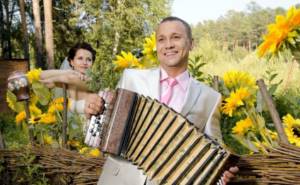
When meeting, the matchmaker on the groom’s side greets everyone: grandparents, aunts, uncles, brothers and sisters. He says that the path was not short, that it took a long time to get there. But they overcame all the difficulties, because they arrived on a very important mission - they say they have a clear falcon, which had a wondrous dream, in which a beautiful maiden appeared to the falcon as a beautiful firebird. Since then, the falcon has not eaten or slept; he keeps thinking about her. And the falcon’s relatives decided to find his betrothed, asked the magic staff for help, and he brought the matchmakers to this house. Naturally, all words are pronounced in a playful, comic form.
The role of the matchmaker in matchmaking
After such a stormy introduction and greeting, the bride's matchmaker comes into play. Again, in a joking manner, he says that he has no idea who he is talking about, that there are many red-haired beauties in the house.
The matchmaker’s surprise on the part of the groom knows no bounds; she asks permission to take everyone at once, to which the groom objects: “No, I don’t need them all, my soul yearns for one!” The groom’s matchmaker, in confirmation of his words, echoes: “Yes! Any swan will not suit our falcon” and suggests that the guy himself start looking for his one and only. After the consent of the girl's parents, he enters the house and brings out his bride.
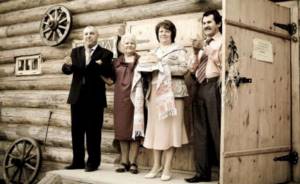
The groom’s matchmaker exclaims enthusiastically: “Of course, she’s beautiful, rosy-cheeked, slim. It is not surprising that the falcon spent so much time drying on it. But we prepared several tests for the swan.” The matchmaker scatters the change on the floor or on the ground. The test begins, during which the girl must show that she is not lazy and can bend over to collect coins. The girl puts the coins in her pocket, and if anyone asks for money, she refuses. The matchmaker immediately notices: “Thrifty! But I have one more question: how much buckwheat do you put in the borscht – a spoon or a glass?” The girl replies: “And I put meat in the borscht!” Everyone nods their heads in approval.
Poems for matchmaking from the bride
Come quickly, the whole family has been waiting for you! Our daughter is getting cuter and sweeter, you can’t take your eyes off her! She has no equal in housekeeping, and is impeccable in beauty! There are no such nice girls, There are no such girls anywhere in the world! So, future son-in-law and beloved matchmakers, We give you this day this dream girl!
Come in, dear guests, into the house, take a place at the festive table. The bride prepared a treat for the matchmakers, We hope you will like it. We will listen to the matchmakers and decide whether it is worth giving the bride to the Groom. But let Love make the main decision, And let the girl answer the guy with consent.
The proposal is clear, Our goods and your merchant, And We will not interfere with the merging of hearts. If the girl doesn’t mind, let the guy marry him, And this wonderful union only brings joy to everyone. Let the beauty think, Weigh everything against and for, The main thing is that her eyes light up joyfully.
We are giving away our beauty. Today we are the groom, That's it, we have wooed the girl, We know for sure - to be kind. We would like to wish the children Happiness, peace and love, So that they may walk along the glorious path, Together and having fun.
We all like your guy, But the beauty must say, Will she go to the altar with him With a light, smooth gait. If the young lady doesn’t mind, Then it’s clear that there will be a wedding, The young will live long in joy and happiness. And now let’s sit down at the table, To discuss the nuances, Give a bright and wonderful holiday to this couple.
A short
Here, groom, is your bride, But not your wife yet! Let everything be fair with you - it’s time for you to celebrate your wedding!
Yes, you have a respectable groom, We will consider the proposal, And the beauty will announce her decision to you later. If she likes the guy, If there is love in her soul, Then we will definitely get together for the wedding with you again.
We are very glad to meet the groom, We like him - handsome, smart and kind, Calm, so strong is his hand, His home with the bride will be reliable. On this day we give a blessing, Love firmly in happiness and patience.
The merchant seems to be strong, and smart, and handsome, and important, but we will win our beauty only when your good fellow promises to take care of her all his life, to care for and cherish her, to blow away specks of dust from her, to love with all his heart and always only to please. If this happens, let the children be happy.
Well, since you came to get married, then be kind enough to promise that our beautiful girl will always be in good hands, in strong arms and under the right protection from all adversities. May your fellow always love and take care of his beloved, may God give them the opportunity to become the happiest and live a wonderful family life without sorrows and worries.
Bread is an essential attribute of matchmaking
After the test, the time comes for the main question: does the girl agree to marry the young man? As a sign of agreement, she must cut the bread into 4 equal parts. And treat each of them to those present: the first two parts are presented, bowing, to the groom’s parents, the second – to his own.
After this, the groom’s matchmaker “marks” the bride so that no one else can take her away before the wedding. With the words: “We will mark with a little thing,” the bride is given a ring. After this, the woman notes that it is the groom’s turn to show himself in action. The guy is given a hammer with nails and he drives a nail into the threshold of the house. After “work,” the groom gives gifts to his future mother-in-law and father-in-law: “For the father-in-law, a hammer, so that he can be useful in the relationship, and for the mother-in-law, a chocolate bar, so that the wedding goes smoothly.”
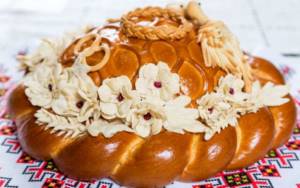
Then everyone goes to the set table, treats themselves, drinks and chats merrily.
